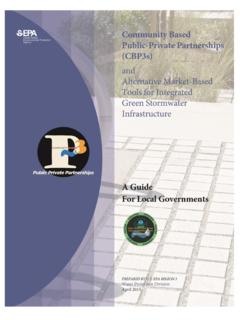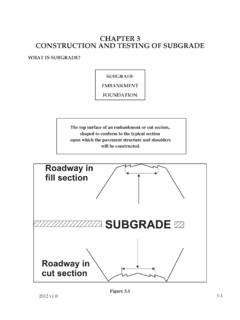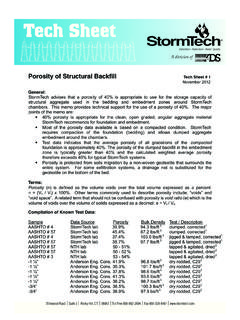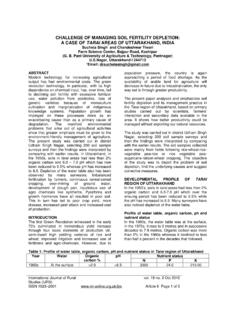Transcription of PowerPoint Presentation
1 4/21/2015114/21/201522 INSTRUCTORSC urtis HinmanSenior Scientist Key project experience: Research specialist in the performance and design of LID practices. Dylan Ahearn PhDAssociate ScientistKey project experience: Stormwatermonitoring and proprietary treatment verification and certification TOPICS IN LID DESIGN: BIORETENTION MEDIA AND PROPRIETARY MEDIA FILTERST raining ProgramStatewide LID4/21/201544introductionmedia primerwater quality treatment strategiesperformanceAGENDA21345wrap-up4 /21/201555 LOGISTICSSCHEDULE 8-hour trainingLunch on your own OTHER LOGISTICS Restrooms Food Turn off cell phones Sign in and sign out4/21/201566 LEARNING an advanced level understanding of the physical and chemical characteristics of bioretentionmedia components and blends necessary to meet specific performance objectives.
2 The flow control and water quality treatment performance of current bioretentionmedia understand the mechanics, performance and operations of proprietary media filters with special attention to phosphorus OVERVIEW 2012: Public and private partners engage state legislature to fund program June 2012: LID Training Steering Committee convened 2012-2013: Washington State LID Training Plan developed: 2014: Training program built from state LID Training OVERVIEW Implement first phase of trainings (September 2014 through May 2015) 64 trainings offered in first phase Three levels: Introductory, Intermediate, and Advanced4/21/201599 PROJECT LEADADDITIONAL TRAINING SUPPORTTEAMCORE TEAM4/21/20151010 Introduction toLID for Eastern WashingtonINTRODUCTORYINTERMEDIATEADVANC EDTRAIN THE TRAINERSS ervice ProvidersIntroduction toLID for Inspection & Maintenance StaffIntroduction toLID for Developers & Contractors.
3 Make Money be GreenIntermediate LID Design: Rainwater Collection Systems & Vegetated RoofsIntermediate LID NPDES Phase I & II RequirementsIntermediate LID Design: Permeable PavementIntermediate LID Design: Hydrologic ModelingAdvanced Topics in LID Design:BioretentionAdvanced Topics in LID Design:Permeable PavementAdvanced Topics in LID Design:Hydrologic ModelingAdvanced Topics in LID Design: Site Assessment, Planning & LayoutLID Topic ExpertsAdvanced Topics in LID Design: Rainwater Collection Systems & Vegetated RoofsAdvanced Topics in LID Design:Bioretention MediaTRAINING SEQUENCEA dvanced Topics for LID Operations: BioretentionIntermediate LID Design: BioretentionAdvanced Topics for LID Operations: Permeable PavementIntermediate LID Design.
4 Site Assessment, Planning & Layout4/21/20151111 Introduction toLID for Eastern WashingtonINTRODUCTORYINTERMEDIATEADVANC EDTRAIN THE TRAINERSS ervice ProvidersIntroduction toLID for Inspection & Maintenance StaffIntroduction toLID for Developers & Contractors: Make Money be GreenIntermediate LID Design: Rainwater Collection Systems & Vegetated RoofsIntermediate LID NPDES Phase I & II RequirementsIntermediate LID Design: Permeable PavementIntermediate LID Design: Hydrologic ModelingAdvanced Topics in LID Design:BioretentionAdvanced Topics in LID Design:Permeable PavementAdvanced Topics in LID Design:Hydrologic ModelingAdvanced Topics in LID Design: Site Assessment, Planning & LayoutLID Topic ExpertsAdvanced Topics in LID Design: Rainwater Collection Systems & Vegetated RoofsAdvanced Topics in LID Design:Bioretention MediaTRAINING SEQUENCEA dvanced Topics for LID Operations: BioretentionIntermediate LID Design: BioretentionAdvanced Topics for LID Operations: Permeable PavementIntermediate LID Design.
5 Site Assessment, Planning & Layout4/21/20151212introduction213454/21 /201513132002 First bioretention applications with monitoring (Seattle SEA Street). Primarily topsoil based Issues with BSM consistency using topsoil emerge. PSAT funds small project through WSU to ID alternative and potentially more consistent materials for BSM. Flow focused. Sand-and compost-based media guideline developed. Report guidelines adopted by Ecology for western WA specification. Sand spec well-tested and performs well hydraulically. OM content spec too high.
6 2011 WSU LID research facility comes online. Media blend research focus (no funding to conduct fundamental media component characterization).In the beginning there wasn t 4/21/201514142012 Export of N, P and Cu identified at WSU facility and City of Redmond swale monitoring. Individual BSM component characterization studies begin at Port of Olympia (Herrera), City of Redmond (Herrera) and at WSU (primarily compost).2013 Ecology funds approximately $1 million in media study projects through Kitsap County (Herrera technical lead), City of Tacoma (UWT technical lead) and City of Redmond (Herrera technical lead).
7 Kitsap County project examining a broad range of individual media components. City of Tacoma project focused on WTRs. Redmond focused on full-scale monitoring of swales (component characterization included). 2015 Significant new data coming available to hopefully improve BSM performance and consistency. We may be a few years from developing a reliable, affordable and non-proprietary BSM to treat a broad suite of s focus: Bioretentionmedia for advanced water quality treatment (direct release to receiving waters, over shallow drinking water aquifers, industrial sites, remedial ) There are many applications where a conventional sand and compost or topsoil-based media will perform For advance treatment media we are opening a complex black And attempting to reliably replicate a dynamic biological system with complex structures and processes to treat a broad range of contaminants to very low worthy challenge!
8 INTRODUCTION4/21/20151717 BACKGROUNDINTRODUCTION Flow Entrance Pre-Settling Ponding Area Bioretention Soil Mulch/Compost Vegetation Filter Fabric (?) Liner (optional) Underdrain (optional) Overflow 4/21/20151818media primer213454/21/20151919 BIORETENTION HYDRAULICS PRIMERMEDIA BASICSF actors influencing hydraulic conductivity Percent fines Particle size distribution4/21/20152020 BIORETENTION HYDRAULICS PRIMERMEDIA BASICSH ydraulic conductivity strongly related to percent fines (passing #200 sieve) 4/21/20152121 BIORETENTION HYDRAULICS PRIMERMEDIA BASICSH ydraulic conductivity strongly related to coefficient of uniformity 4/21/20152222 BIORETENTION HYDRAULICS PRIMERMEDIA BASICSF actors influencing hydraulic conductivity Percent fines Particle size distribution Compaction Organic material Plants4/21/20152323 BIORETENTION HYDRAULICS PRIMERMEDIA BASICSC ontrol structures4/21/20152424 BIORETENTION HYDRAULICS PRIMERMEDIA BASICS ASTM D24344/21/20152525 Break4/21/20152626 WATER QUALITY TREATMENT PRIMERMEDIA
9 BASICSAll primary pathways for removing pollutants from storm flows are active in bioretention Stormwatervolume reduction Sedimentation Filtration Phytoremediation Thermal attenuation Sorption Complexation Volatilzation4/21/20152727 WATER QUALITY TREATMENT PRIMERF actors influencing water quality treatment pH Temperature Hydraulic residence time Media (organic material, particle size, porosity, chemistry) Competing ions, ionic chemistry Soil water condition Influent concentrationMEDIA BASICS4/21/20152828 WATER QUALITY TREATMENT PRIMERIs the following statement correct?
10 If an influent concentration of 5 g/L into a bioretentionarea results in an effluent concentration of 10 g/Lthen an influent concentration of 50 g/L will result in an effluent concentration of 100 BASICS4/21/20152929 WATER QUALITY TREATMENT PRIMERS orption Ionic charge and speciation Functional groups (moiety) Organic material (TOC and DOC) Competing ions and ion exchange Particle sizeMetal FractionMobilityExchangeable FractionHigh. Changes in major cationic compositions may cause release due to ion exchangeFe-MnOxides BoundCarbonate BoundMedium.






